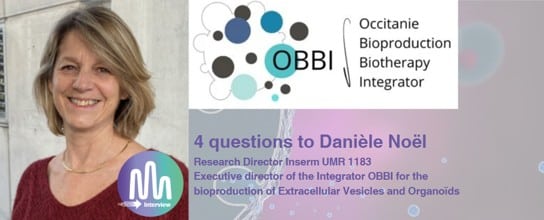Can you introduce us to the OBBI platform and the role it aims to play in the production of Extracellular Vesicles?
OBBI is a unique service unit offering an integrated range of services based on know-how, expertise and innovation to accelerate and facilitate the development of bioproductions of extracellular vesicles (EVs) and organoids. This structure has a national reach and international ambitions.
OBBI interacts with biotech, industrial and academic partners to meet their needs for robust, reproducible processes in order to provide innovative solutions for tomorrow’s treatments. Located in Montpellier and Toulouse, the platforms and expertise associated with OBBI offer advanced development, optimisation, standardisation and characterisation capabilities for the development of extracellular vesicle and organoid production, with a view to applications in research, industry and the clinic. In the field of extracellular vesicles, OBBI is a major partner in the development of new production processes and the characterisation of nanoparticles by applying quality control standards compatible with the needs of industry and the clinic.
How do you characterize your EV productions, and what are the limitations of current technologies?
The characterisation of extracellular vesicles that we are using is based on standard techniques using interferometry, nanoparticle tracking analysis (or NTA) to measure the size and concentration of extracellular vesicles and, nanocytometry or western blot to identify and quantify the molecules present in extracellular vesicles. We also have a super-resolution microscope that can identify single molecules at the scale of a single vesicle. These complementary technologies are limited by the size range and detection sensitivity of the apparatus used and do not provide the fullsize distribution reflecting the size heterogeneity of isolated extracellular vesicle suspensions on a single apparatus.
A whole range of sizes below 80-100 nm is currently difficult to access using conventional techniques. However, it is well known that nano-objects smaller than 50 nm are widely present in environments containing EVs (proteins, nanoparticles). What benefits could you gain from a technology like Taylor Dispersion Analysis, which allows for the characterization and quantification of these species?
The benefits of a technology that would enable us to visualise objects smaller than 50 nm would be to better identify and quantify the heterogeneity of nanoparticle suspensions isolated from culture supernatants or biological fluids, better understand the biogenesis of extracellular vesicles and more accurately characterise the types of nanoparticles produced or lipoprotein contaminants. Access to this sub-50 nm range could also support the detection of previously unresolved populations, such as protein aggregates, small lipoproteins, or residual components from purification steps, and contribute to refining separation and quality control strategies. A technology offering such resolution could complement existing tools in the analytical workflow.
What applications can be envisioned with the use of Small EVs smaller than 50 nm?
An emerging application would be the study of exomers and supermers, which are non-vesicular nanoparticles that have recently been characterised and whose study is hampered by the limited tools available.

